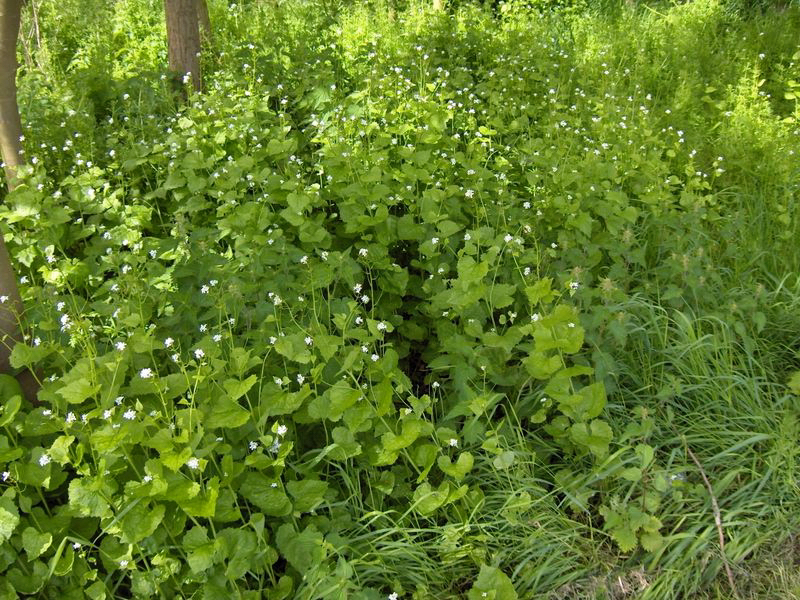
MIKE MILLER
For those unfamiliar with Garlic Mustard, Alliaria petiolata, it is a biennial plant with a two-year lifecycle. It’s first year, it survives as a basal rosette of leaves. During its second year, it will produce flowering stalks and set seed. One reason that ecologists are concerned is that it is a species introduced to North America from Europe that has the ability to crowd out native species. There is some debate as to when it was introduced. The earliest records seem to indicate that it was found growing on Long Island in 1868. It was most likely introduced into North America by immigrants from central Europe as a garden herb. Today, it can be found growing in 34 states and three Canadian provinces.
Garlic Mustard became a problem in North America because there were no native species here that use it as a forage or food source. In its native Europe, more than 70 insects and seven species of fungus will keep this plant in check. In the fields and pastures of Europe, Garlic Mustard is just another wildflower that co-exists with other species in balance. Here in North America, it is a completely different animal. It likely came to North America with European settlers who used it as a culinary herb. It does make a decent pesto!
There have been numerous studies seeking to find a biological control for Garlic Mustard. Surely, there must be a species of insect from central Europe that could assist in the control of Garlic Mustard. After all, we have found insects that can assist in the control of Purple Loosestrife Lythrum salicaria. While there is some promise with finding a biological control, there are many obstacles standing in the way of such a path. For starters, Garlic Mustard comes from a very different plant family than Purple Loosestrife. The Loosestrife Family, Lythraceae, is fairly small. For example, only about nine species from this family are found in Illinois, and in the world-wide scope, there isn’t a lot of other plants related to it. Therefore, finding a specialist insect that will eat Purple Loosetrife (and only Purple Loosetrife) is a possibility.
Finding a biological control for Garlic Mustard is a completely different beast. The Mustard Family, Brassicaceae, is huge. There are more than 150 species found in Illinois alone. World-wide, the Mustard Family comprises several thousand species, many of which are very important agricultural crops, including cabbages, broccoli, spinach, Brussel sprouts, radishes, and mustards. While kids might not miss Brussel sprouts, you can see that finding a critter that eats only Garlic Mustard can be a much harder task. There is just so many other plants related to it, the testing of potential insect controls is much more time consuming. That being said, the search for a biological control is under way, but it is going to take a lot of time and effort.
Until some wonderous biological control comes along, natural area enthusiasts will need to borrow an age-old tactic from the gardener … Weeding. This strategy involves first defining populations of Garlic Mustard into three general categories; Satellite Infestations, Invasive Front, and Core Infestations. Garlic Mustard spreads from established core infestations along an invasive front. Satellite infestations occur when seeds are transported to new areas. This often occurs along trails (both human and animal). You can guess what will happen to these satellite infestations should they go unchecked. Focusing on weeding these smaller satellite populations can go a long way toward keeping Garlic Mustard from taking over new areas. Tackling core infestations and invasive fronts often need more intensive work, and may be beyond the weekend warrior. It is important to remove the entire plant from the area after it is picked. When the plant is pulled, and left lying on the ground it can still produce viable seeds. Bring a bag, and hike the plant out of the area and dispose of it properly.
There are several opportunities at natural areas and nature centers throughout the region to learn how to identify Garlic Mustard and assist with its removal. Forest Park Nature Center in Peoria Heights is a great place to learn about this (and other) invasive species. They also regularly hold “Garlic Mustard Pulls” throughout the spring. Call (309) 686-3360 to learn more.
More information on Garlic Mustard Control can be found at: https://www2.illinois.gov/dnr/INPC/Documents/VMG/VMG%2010%20Garlic%20mustard%20revised%202017.pdf.

